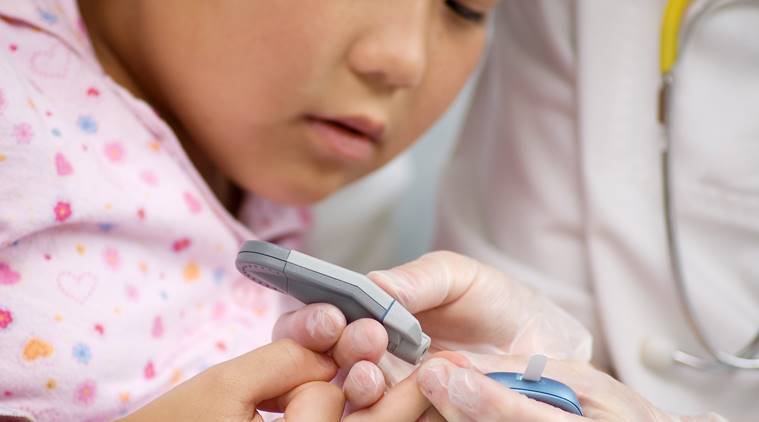Childhood Obesity and Type 2 Diabetes: Early Intervention for a Lifetime of Health
Table of Contents

Introduction
Childhood obesity has become a growing epidemic, with prevalence rates increasing over the past few decades. The World Health Organization (WHO) has reported that the number of overweight or obese children under the age of 5 has increased from 32 million globally in 1990 to 41 million in 2016 [1]. This trend is concerning because childhood obesity is associated with various adverse health outcomes, including an increased risk of developing type 2 diabetes.
Type 2 diabetes, once considered a disease of adulthood, is now affecting an increasing number of children and adolescents worldwide. A study in the United States estimated that approximately 20% of children with diabetes have type 2 diabetes, which is projected to increase in the coming years [2]. The association between childhood obesity and type 2 diabetes is well-established, with overweight or obese children at a higher risk of developing type 2 diabetes than their normal-weight counterparts [3].
Early intervention
Early intervention is crucial in preventing or delaying the onset of type 2 diabetes in children with obesity. Screening for type 2 diabetes in children and adolescents with a high risk of developing the condition can help identify those who require early intervention. In addition, lifestyle interventions, such as diet and exercise, have been shown to prevent or delay the onset of type 2 diabetes in high-risk children [4].
This article aims to highlight the importance of early intervention for childhood obesity and type 2 diabetes. We will discuss the health consequences of childhood obesity and type 2 diabetes and the benefits of early intervention. We will review screening recommendations and treatment options for children at risk of developing type 2 diabetes. Finally, we will address the challenges of early intervention and offer solutions to overcome barriers. With early intervention, we can ensure a lifetime of health for children at risk of developing type 2 diabetes.
Childhood Obesity
Childhood obesity is a growing health concern worldwide. In the United States, approximately 18.5% of children and adolescents are considered obese, with rates increasing among certain ethnic and socioeconomic groups [1]. The prevalence of childhood obesity is concerning, given the associated health consequences, including an increased risk of type 2 diabetes, cardiovascular disease, and other chronic conditions [2].
The causes of childhood obesity are multifactorial and include genetic, environmental, and behavioural factors. In particular, the modern-day food environment, characterised by easy access to high-calorie, low-nutrient foods and drinks, has been identified as a significant contributor to childhood obesity [3]. In addition, physical inactivity and sedentary behaviour, such as excessive screen time, have also been linked to obesity in children [4].
The health consequences of childhood obesity
The health consequences of childhood obesity are numerous and can have significant long-term implications for health. Obese children are at an increased risk of developing type 2 diabetes, a condition that was once considered rare in children but is now increasingly prevalent [5]. Children with obesity are also at an increased risk of developing cardiovascular disease, including hypertension, dyslipidemia, and atherosclerosis [6]. In addition, obese children are more likely to experience psychosocial problems, such as depression, anxiety, and low self-esteem, which can harm their overall quality of life [7].
Prevention and treatment options
Prevention and treatment options for childhood obesity are focused on promoting healthy lifestyle behaviours, such as increasing physical activity, reducing sedentary behaviour, and improving dietary habits. Evidence suggests that a combination of lifestyle interventions, including behaviour modification, nutritional changes, and physical activity, can significantly reduce body mass index (BMI) and improve overall health outcomes in children with obesity [8]. In addition, family-based interventions involving parents or caregivers have effectively promoted healthy behaviours in children [9].
Multidisciplinary approach
The treatment of childhood obesity requires a multidisciplinary approach that involves healthcare professionals, educators, and families. Healthcare providers are critical in identifying and managing childhood obesity through routine screening, counselling on healthy behaviours, and referral to appropriate resources [10]. Schools also play an essential role in promoting healthy behaviours in children through physical education, healthy food options, and opportunities for physical activity [11]. Finally, families are key players in preventing and treating childhood obesity, as they are responsible for creating a healthy home environment that promotes healthy behaviours [12].
In conclusion, childhood obesity is a significant public health concern with far-reaching consequences for health. The associated health consequences, such as an increased risk of type 2 diabetes and cardiovascular disease, highlight the importance of early intervention in preventing or managing childhood obesity. Promoting healthy lifestyle behaviours, including physical activity, reduced sedentary behaviour, and improved dietary habits, is crucial in preventing and managing childhood obesity. Multidisciplinary approaches involving healthcare providers, educators, and families are necessary to address this complex issue and ensure a lifetime of health for children at risk of developing obesity.
Type 2 Diabetes
Type 2 diabetes is a chronic metabolic disorder characterised by insulin resistance and impaired glucose tolerance. Once considered a disease of adulthood, type 2 diabetes is becoming increasingly prevalent in children and adolescents, particularly those with obesity [1]. The prevalence of type 2 diabetes in children and adolescents is estimated to be 0.5-1.0%, with rates increasing among certain ethnic and racial groups [2].
The causes of type 2 diabetes in children and adolescents are multifactorial and include genetic, environmental, and behavioural factors. In particular, obesity and sedentary behaviour have been identified as significant risk factors for developing type 2 diabetes in children and adolescents [3]. Other risk factors include a family history of type 2 diabetes, certain medical conditions such as polycystic ovary syndrome, and glucocorticoid medications [4].
The health consequences of type 2 diabetes
The health consequences of type 2 diabetes in children and adolescents are significant and include an increased risk of microvascular and macrovascular complications, such as retinopathy, nephropathy, and cardiovascular disease [5]. Children and adolescents with type 2 diabetes are also at risk for psychosocial problems, such as depression and anxiety, which can harm their overall quality of life [6].
Early intervention is crucial in preventing or delaying the onset of type 2 diabetes in at-risk children and adolescents. Screening for type 2 diabetes in high-risk children and adolescents can help identify those who require early intervention. The American Diabetes Association recommends screening for type 2 diabetes in children and adolescents who are overweight or obese and have at least two additional risk factors, such as a family history of type 2 diabetes or signs of insulin resistance [7].
The management of type 2 diabetes
The management of type 2 diabetes in children and adolescents requires a multidisciplinary approach that involves healthcare providers, educators, and families. Lifestyle interventions, such as diet and exercise, are the cornerstone of treatment for type 2 diabetes in children and adolescents. Evidence suggests that lifestyle interventions can significantly improve glycemic control, blood pressure, and lipid levels in children and adolescents with type 2 diabetes [8]. In addition, pharmacologic therapy may be necessary in some cases to achieve glycemic control.
In conclusion, type 2 diabetes is a growing health concern in children and adolescents, particularly those with obesity. Early intervention through screening and lifestyle interventions is critical in preventing or delaying the onset of type 2 diabetes in high-risk children and adolescents. The management of type 2 diabetes in children and adolescents requires a multidisciplinary approach that involves healthcare providers, educators, and families. By promoting healthy lifestyle behaviours and providing appropriate medical management, we can ensure a lifetime of health for children and adolescents with type 2 diabetes.
Early Intervention
Early intervention is crucial in preventing or delaying the onset of type 2 diabetes in children and adolescents with obesity. Screening for type 2 diabetes in high-risk children and adolescents can help identify those who require early intervention. The American Diabetes Association recommends screening for type 2 diabetes in children and adolescents who are overweight or obese and have at least two additional risk factors, such as a family history of type 2 diabetes or signs of insulin resistance [1].
In addition to screening, lifestyle interventions are vital in preventing or delaying the onset of type 2 diabetes in high-risk children and adolescents. Behaviour modification, dietary changes, and physical activity effectively reduce the risk of type 2 diabetes in children and adolescents with obesity [2]. Family-based interventions involving parents or caregivers have also been shown to promote healthy behaviours in children and adolescents with obesity [3].
Dietary interventions
Dietary interventions for children and adolescents with obesity aim to improve the quality of the diet by reducing the intake of high-calorie, low-nutrient foods and increasing the intake of nutrient-dense foods, such as fruits and vegetables [4]. Behavioural interventions may involve goal-setting, self-monitoring, and problem-solving to help children and adolescents adopt healthy behaviours [5].
Physical activity is also essential to early intervention for type 2 diabetes in children and adolescents with obesity. The American Academy of Pediatrics recommends that children and adolescents engage in at least 60 minutes of moderate to vigorous physical activity daily [6]. Regular physical activity has been shown to improve insulin sensitivity and reduce the risk of type 2 diabetes in children and adolescents with obesity [7].
Pharmacologic therapy
In cases where lifestyle interventions are not effective in preventing or delaying the onset of type 2 diabetes in children and adolescents with obesity, pharmacologic therapy may be necessary. Metformin, an oral antihyperglycemic medication, effectively reduces the risk of type 2 diabetes in high-risk children and adolescents with obesity [8].
In conclusion, early intervention is crucial in preventing or delaying the onset of type 2 diabetes in children and adolescents with obesity. Screening for type 2 diabetes and lifestyle interventions, such as behaviour modification, dietary changes, and physical activity, are critical components of early intervention. Family-based interventions involving parents or caregivers can also effectively promote healthy behaviours. By promoting healthy lifestyle behaviours and providing appropriate medical management, we can ensure a lifetime of health for children and adolescents with obesity who are at risk of developing type 2 diabetes.
Benefits of Early Intervention
Early intervention for childhood obesity and type 2 diabetes can have numerous benefits for children and adolescents in the short and long term. Lifestyle interventions, such as behaviour modification, dietary changes, and physical activity, effectively reduce the risk of type 2 diabetes in high-risk children and adolescents with obesity [1].
One of the main benefits of early intervention is preventing or delaying the onset of type 2 diabetes in children and adolescents with obesity. Promoting healthy lifestyles and providing appropriate medical management can reduce the risk of developing type 2 diabetes and its associated health consequences, such as cardiovascular and kidney disease [2].
Improvements in other health outcomes
In addition to reducing the risk of type 2 diabetes, early intervention can improve other health outcomes. Children and adolescents who participate in lifestyle interventions have been shown to have improvements in blood pressure, lipid levels, and glycemic control [3]. These improvements can significantly impact overall health and reduce the risk of developing other chronic conditions later in life.
Early intervention can also have positive psychosocial effects on children and adolescents with obesity. Children and adolescents who participate in lifestyle interventions have been shown to have improvements in self-esteem, body image, and quality of life [4]. These improvements can have a positive impact on mental health and can help to prevent the development of psychosocial problems later in life.
Potential to reduce healthcare costs
Another benefit of early intervention is the potential to reduce healthcare costs associated with childhood obesity and type 2 diabetes. The healthcare costs associated with these conditions can be significant and negatively impact families and healthcare systems [5]. By preventing or delaying the onset of type 2 diabetes and other chronic diseases, we can reduce healthcare costs and improve overall healthcare outcomes.
In conclusion, early intervention for childhood obesity and type 2 diabetes can benefit children and adolescents. Promoting healthy lifestyles and providing appropriate medical management can reduce the risk of developing type 2 diabetes and other chronic conditions, improve overall health outcomes, and reduce healthcare costs. Family-based interventions involving parents or caregivers can also promote healthy behaviours and improve overall health outcomes.
Challenges and Solutions
Despite the benefits of early intervention for childhood obesity and type 2 diabetes, several challenges must be addressed to ensure its success. These challenges include cultural and socioeconomic barriers, lack of access to healthcare, and lack of family support [1].
One of the main challenges is cultural and socioeconomic barriers. Certain cultural and socioeconomic factors can influence dietary habits and physical activity patterns, making it more difficult for some families to adopt healthy behaviours. For example, some low-income families may need access to affordable healthy foods or safe places to engage in physical activity. Addressing these barriers may require a community-based approach that involves multiple stakeholders, including healthcare providers, schools, and local government [2].
Lack of access to healthcare
Another challenge is the need for more access to healthcare. Children and adolescents with obesity and type 2 diabetes may not have access to healthcare services that can provide appropriate screening and management. This may be due to a need for more insurance coverage or a shortage of healthcare providers in certain areas. Improving access to healthcare services, particularly in underserved areas, is critical in ensuring that children and adolescents with obesity and type 2 diabetes receive the care they need [3].
Lack of family support can also be a barrier to early intervention. Children and adolescents may struggle to adopt healthy behaviours if their families are not supportive or engaged. Family-based interventions involving parents or caregivers effectively promote healthy behaviours in children and adolescents with obesity [4]. Encouraging family involvement and providing support and resources can help to overcome this challenge.
Solutions
In addition to addressing these challenges, several solutions can help promote successful early intervention for childhood obesity and type 2 diabetes. These solutions include improving access to healthy foods, promoting physical activity, and providing education and resources to families. Healthcare providers can be vital in promoting early intervention by providing screening and referrals to appropriate services.
Schools can also be important in promoting healthy behaviours and early intervention for childhood obesity and type 2 diabetes. Schools can provide nutritious meals and snacks, offer physical education classes and extracurricular activities, and educate students and families about healthy behaviours. Schools can partner with healthcare providers and community organisations to provide additional resources and support.
Community-based interventions
Community-based interventions can also be effective in promoting early intervention. Community organisations can provide resources and support to families, offer programs and activities that promote healthy behaviours, and advocate for policies and initiatives that support healthy lifestyles.
In conclusion, while there are challenges to early intervention for childhood obesity and type 2 diabetes, solutions can help overcome these challenges. Addressing cultural and socioeconomic barriers, improving access to healthcare, and promoting family involvement are critical in ensuring the success of early intervention. By promoting healthy behaviours and providing appropriate medical management, we can ensure a lifetime of health for children and adolescents with obesity who are at risk of developing type 2 diabetes.
Conclusion
In conclusion, childhood obesity and type 2 diabetes are significant public health issues that require early intervention to prevent or delay the onset of chronic conditions and improve overall health outcomes. Early intervention, including screening and lifestyle interventions such as behaviour modification, dietary changes, and physical activity, can help reduce the risk of developing type 2 diabetes and other chronic conditions, improve overall health outcomes, and reduce healthcare costs. Family-based interventions involving parents or caregivers can promote healthy behaviours and improve overall health outcomes.
Solutions that promote successful early intervention
Despite the challenges that exist in addressing childhood obesity and type 2 diabetes, such as cultural and socioeconomic barriers, lack of access to healthcare, and lack of family support, some solutions can help to promote successful early intervention. These solutions include improving access to healthy foods, promoting physical activity, providing education and resources to families, and community-based interventions.
By addressing these challenges and implementing solutions, we can ensure a lifetime of health for children and adolescents with obesity who are at risk of developing type 2 diabetes. Healthcare providers, schools, community organisations, and policymakers must work together to promote healthy behaviours and provide appropriate medical management for children and adolescents with obesity and type 2 diabetes.
References
- World Health Organization. (2018). Childhood overweight and obesity. Retrieved from https://www.who.int/news-room/fact-sheets/detail/childhood-overweight-and-obesity
- American Diabetes Association. (2021). Type 2 Diabetes in Children and Adolescents. Retrieved from https://www.diabetes.org/diabetes/type-2-children-and-adolescents
- World Obesity Federation. (2019). Childhood Obesity and Type 2 Diabetes. Retrieved from https://www.worldobesity.org/news/childhood-obesity-and-type-2-diabetes
- American Academy of Pediatrics. (2017). Clinical Practice Guideline for the Diagnosis, Evaluation, and Treatment of Overweight and Obesity in Children and Adolescents. Retrieved from https://pediatrics.aappublications.org/content/early/2017/08/17/peds.2017-1911
- Centers for Disease Control and Prevention. (2022). Childhood Obesity Facts. Retrieved from https://www.cdc.gov/obesity/data/childhood.html
- Dabelea, D., et al. (2014). Incidence of type 2 diabetes in the United States among children and adolescents aged 10-19 years, 2002-2012. JAMA, 311(17), 1778-1786.
- Weiss, R., & Caprio, S. (2011). The metabolic consequences of childhood obesity. Best Practice & Research Clinical Endocrinology & Metabolism, 25(3), 405-418.
- Zeitler, P., et al. (2014). ISPAD Clinical Practice Consensus Guidelines 2014. Type 2 diabetes in the child and adolescent. Pediatric Diabetes, 15(S20), 26-46.








